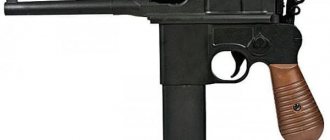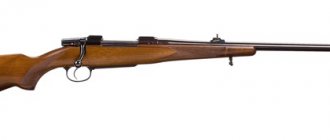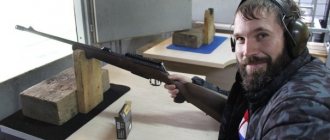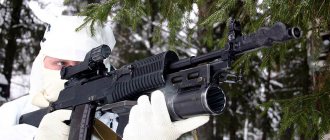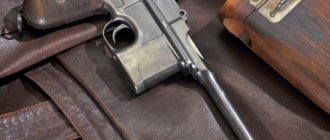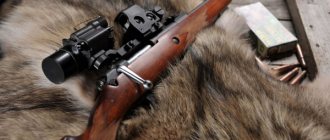The Second World War was the most tragic milestone in the history of the last century. She has inflicted wounds that will take a long time to heal. But it was she who gave humanity a huge number of new technologies and mechanisms that are still used today. Of course, this statement is most true in relation to weapons. Some models, which were widely used on the battlefields, have successfully survived to this day and are not going to give up their positions.
This is the case with the German Mauser 98K carbine. Contrary to popular belief, it is this, and not the “canonical” MP-38/40 submachine gun, that can be considered the real “calling card” of an ordinary Wehrmacht infantryman. The design of this weapon was so successful that it was the most respected German rifle of World War II. Even today, hunting carbines are made from old Mausers everywhere, and modern replicas are also produced. Read about the history of this weapon and its characteristics in this article.
Differences from the rifle
The carbine has the following features that distinguish it from a rifle: the barrel is 60 cm long (Gewehr is 74 cm), the bolt handle is bent downwards, and in the stock there is a special recess for its handle. The main difference (initially) is that the front swivel is a single unit with the stock ring, and therefore the belt is attached “cavalry style” (more on this below).
There is no rear swivel at all: instead there is a slot in the butt, protected from wear by a metal edging. A very important and useful feature of this weapon is that the empty clip did not need to be removed manually, since after the magazine was empty (while charging), it simply fell out through a special slot. In addition, after the cartridges ran out, the bolt remained in the open position. Coupled with the previous innovation, this circumstance made recharging much more comfortable. In total, about 14.5 million samples were produced.
Technical Note
Initially, the letter “K” in the name meant, rather, the cavalry affiliation of the weapon. It didn’t become “short” right away. The fact is that in the German army, “carbines” were for a long time considered modifications of ordinary linear rifles, the main difference of which was not the length, but the method of attaching the weapon belt, which was more suitable specifically for cavalrymen! Only later in the German language did this term acquire its global meaning.
That’s why many sources call the Mauser 98K a “lightweight rifle.” The bolt closes when turned 90 degrees and has three lugs. The charging handle is attached to it from the back. As we already mentioned, it is curved downwards. This gave several advantages:
- Firstly, reloading weapons was again made easier.
- Secondly, the handle, placed in a slot on the stock, is much more convenient in field conditions than a “lever” sticking out to the side.
- Finally, you can immediately install an optical sight on any Mauser 98K without having to remake the carbine (as is the case with the original Gewehr and the Mosin rifle).
All this, coupled with the small size of the weapon, made the 98K model a real “hit” not only in the German army. Neither Soviet, nor English, nor Yugoslav soldiers disdained to use captured rifles. I was also impressed by the powerful caliber of the weapon, which allowed me to shoot further and more accurately.
Technical features of the bolt group
There are several holes in the shutter itself. Through them, in the event of a breakthrough of powder gases from the cartridge case at the moment of firing, the latter are retracted back and down into the magazine cavity. Another feature is the extremely massive ejector. It performs two important functions: firstly, it firmly bites the featureless flange of a German-style cartridge, simultaneously holding it firmly on the shutter mirror.
This is a very important circumstance, since thanks to it (when using normal ammunition), Mausers practically never have cases where the cartridge case could not be removed from the chamber. The Three Lines were not so happy with this. In general, Wehrmacht weapons were almost always of high quality and fairly decent reliability, especially in the early stages of the war.
On the bolt lock there is an ejector responsible for ejecting spent cartridges. This latch is located on the left side of the receiver and securely holds the bolt itself in it. To remove it for visual inspection or replacement, you first need to put the fuse in the middle position, and then, pulling the front part of the lock towards you, pull out the bolt.
Store information
The store is two-row, box-type. Located inside the receiver. It is the magazine that makes the Mausers very different from many rifles of that time, since it does not protrude beyond the boundaries of the rifle/carbine itself. German gunsmiths achieved this by taking advantage of two factors: firstly, the cartridge used by the Reichswehr and Wehrmacht did not have a clearly defined flange, while the same detail on 7.62x54R cartridges spoiled a lot of blood for domestic gunsmiths. Because of this, the ammunition could be pressed closer to each other. The use of a “chessboard” layout made the Mauser magazine as compact as possible.
These Wehrmacht weapons can be equipped with ready-made clips for five rounds, or individually. To load a magazine using a clip, it had to be placed in specially designed grooves in the receiver, and then the cartridges should be vigorously squeezed out using the thumb. After jerking the shutter, the clip was automatically knocked out of the grooves (through the slot we talked about above).
If the weapon needs to be unloaded, you should use the bolt, pulling it as many times as there are cartridges left in the carbine. Under the trigger guard there is a spring-backed latch, which provides access to the magazine cavity if it is necessary to clean it or perform maintenance.
It is strictly forbidden to load a cartridge into the chamber manually, as this sharply increases the risk of breaking the ejector tooth, which cannot be repaired in the field. In general, the German Mauser rifle was extremely reliable, but it also had similar weak points (the Mosinka’s Achilles’ heel was the reflector on the bolt).
The main advantages of the Mauser 98k carbine compared to the Mosin rifle
So which rifle is better: the German Mauser 98k or the Russian “three-line”? They were developed at approximately the same time and had similar cartridge calibers and properties.
The German rifle has a number of undeniable advantages: it is more convenient, it does not have a protruding magazine, and the safety is very ergonomic. It is necessary to emphasize the cartridge that was used on the Mauser 98k. It was the absence of a flange on the cartridge case that provided many of the advantages of the rifle.
Disassembly of the German rifle was ordinary and did not require additional tools.
In addition, the Mosin rifle had the least successful stock, which was more suitable for bayonet fighting than for precise shooting. When reloading the rifle, the butt had to be removed from the shoulder, which reduced the rate of fire and confused the aim. The “three-ruler” had a tight and long descent, which did not help increase shooting accuracy. The Russian rifle had to be sighted with a bayonet, otherwise the point of impact would move to the side, and it was very awkward to always carry a rifle with a bayonet. Over time, the bayonet became loose, which significantly reduced accuracy.
The frame clip that was used on the “three-line” did not contribute to the loading speed in battle.
These are only the main shortcomings of the Mosin rifle. Yes, it was very reliable, had a powerful cartridge and was easy to manufacture. But already at the beginning of the First World War it was not the most modern; at the beginning of the 2nd World War it can safely be called outdated.
USM (trigger mechanism)
A simple striker-type trigger. The trigger stroke is quite long and smooth, which is why this weapon was very loved by snipers. The firing pin is cocked when the bolt is turned. Its spring is located inside the bolt. To visually locate it, there is no need to carefully inspect the shutter, since this part is easily visible from the shank protruding backwards.
There is a changeover type fuse located at the rear of the fuse. It has three possible positions:
- Bent to the right - combat position, fire.
- Vertical position - blowback, safety is active.
- Bent to the left - the safety is on when the bolt is locked.
In the literature there is often a statement that the fuse on the Mauser is more convenient than a similar system on the Three Line. The authors argue their opinion by the fact that with the upper vertical position of its petal, supposedly, a soldier could easily determine whether it was possible to shoot from a rifle or not. But here we should look again at the description of its positions: with the safety on in the middle position, no normal infantryman would walk, since in this case it was possible to simply lose the bolt. A fun move in battle!
However, it should be admitted that controlling the fuse on the K98 is indeed much simpler: it changes position more easily and is much easier to handle with gloves. So this German rifle is much more ergonomic than the types of small arms common at that time.
Description of the gun design
custom_block(5, 69903295, 3924);
The Mauser 98k is a bolt-action repeating rifle. The bolt rotates 90 degrees when the barrel bore is locked; it has as many as three lugs, which ensures only strong locking. In addition, the bolt has a special gas outlet, which, when powder gases break through, takes them down into the magazine cavity.
The bolt is simply removed from the rifle; no special tools are required. To remove it, simply pull back the special lock and pull the bolt back.
One of the features of the Mauser 98k action is a powerful and very reliable ejector that extracts cartridges from the chamber.
The trigger mechanism is striker-type, the firing pin is cocked when the handle is turned while the bolt is opening. At the rear of the bolt there is a safety switch that has three positions. All that can be said about the safety device is that it is very comfortable. One horizontal position covers the bolt, in a vertical position the bolt is free, in another horizontal position you can fire.
The safety design is an undeniable advantage of the Mauser 98k carbine. The raised flag obviously tells the fighter that it is impossible to shoot, besides, it is very ergonomic and comfortable, you can simply handle it with gloves.
The Mauser 98k has a long and smooth trigger pull, which is why snipers adored this weapon.
The rifle is fed from a magazine with a capacity of 5 rounds. A few words should be said about it separately. The magazine on the Mauser 98k is double-row, box-shaped and non-removable; it is completely located in the stock. The cartridges in it are arranged in a checkerboard pattern. The designers of the Mauser Gewehr 98 and Mauser 98k rifles were able to ensure that the magazine does not completely protrude beyond the dimensions of the gun. This is very comfortable to use and distinguishes the Mauser 98k from most rifles of that time.
German gunsmiths were able to achieve similar results by using a 7.92x57 mm cartridge, the cartridge case of which did not have a flange, and also using a “chessboard” arrangement of cartridges in the magazine. The 7.62x54 mm R cartridge, which was used in the Russian “three-line”, had a flange on the cartridge case, which increased the size of the magazine and also created obstacles when extracting cartridges from the gun.
The Mauser 98k rifle could be loaded either with a clip or with one cartridge at a time. Manually inserting a cartridge into the chamber was strictly prohibited.
The Mauser 98k sights consist of a regular rear sight and front sight. The dovetail front sight is adjustable. The sight was on the barrel, it was adjustable at distances from 100 to 1000 meters.
The stock is made of wood, with a pistol-type handle. The butt has a metal butt plate. At first, the stock and butt were made of walnut wood; later, stamped plywood began to be used more and more often for the production of the stock. A special recess was made in the butt for storing accessories.
Both Mauser Gewehr 98 and Mauser 98k were equipped with blade-type bayonets, which were attached to a special tip of the stock. In Germany, seven types of bayonet knives (these are only the main types) were created for this weapon. The standard bayonet for the Mauser 98k carbine was the SG 84/98, which was much shorter and lighter than that of the Mauser Gewehr 98. The importance of bayonet combat during World War II decreased significantly, therefore, since 1944, carbines were no longer equipped with a bayonet. knives.
About sights
The mechanics cannot boast of anything impressive: the usual front and rear sights. The sight could be adjusted from 100 to 1000 meters. The front sight is mounted in the Dovetail mount, known in the Warsaw Pact countries. Lateral edits are possible. The placement of the rear sight is on the barrel, in front of the receiver.
It should be noted that the Germans, like Soviet specialists, did not produce special sniper versions of Gw.98 carbines and rifles. For this purpose, weapons were selected from standard factory batches. For selection purposes, shooting was carried out under “reference” conditions. For this, the Germans used SmE cartridges with a steel core (“E” - Eisenkern).
Especially for snipers in 1939, the ZF39 optical sight was developed and adopted for service. A year later, experts improved it by adding markings up to 1200 meters. The sight was placed directly above the bolt, and throughout the war the design of the sight was changed several times.
Technical properties
| Model | Mauser Gewehr 98 | Karabiner 98k |
| Manufacturer | Mauser-Werke AG | |
| Cartridge | 7.92x57mm Mauser | |
| Caliber | 7.92 mm | |
| Weight without cartridges | 4.1 kg | 3.7 kg |
| Weight with cartridges | n/a | |
| Length | 1250 (with 1500 bayonet) mm | 1100 (with bayonet 1340) mm |
| Barrel length | 740 mm | 610 mm |
| Number of grooves in the barrel | 4 right-hand | |
| Trigger mechanism (trigger mechanism) | Impact type | |
| Principle of action | Sliding butterfly valve | |
| Fuse | Flag | |
| Aim | Front sight and rear sight | Front sight with muzzle and rear sight |
| Effective range | 500 m | |
| Sighting range | 2000 m | 1000 m |
| Initial bullet speed | 878 m/s | 860 m/s |
| Type of ammunition | Integral two-row magazine | |
| Number of cartridges | 5 | |
| Years of production | 1898–1945 | 1935–1945 |
New optical sights
A month after the start of the war with the Soviet Union, in July 1941, the ZF41 model was adopted, which is often found in the literature under the names ZF40 and ZF41/1. But 98K carbines with these sights began to enter the Wehrmacht troops only at the end of the year. Their characteristics were quite modest, and the standard Mauser 98K cartridges from the initial period of the war were not very good for such shooting.
Firstly, with a length of 13 centimeters, the sight provided only x1.5 magnification. In addition, its fastening was so poor that it seriously interfered with the process of reloading the weapon. Due to poor magnification, snipers preferred to use the ZF40 only at medium ranges. Moreover, the manufacturer himself did not hide the fact that the Mauser 98K carbine, which was equipped with such a sight, should have been perceived exclusively as a weapon of increased accuracy, but not at all as a sniper “tool”. Therefore, already in 1941, many Germans removed the ZF41 from rifles, but their production still continued.
The new telescopic sight ZF4 (43/43-1) was... an almost exact copy of the Soviet product, adjusted for German manufacturing technologies. The Wehrmacht was never able to establish a stable production of the new model, and there simply were no mounts specifically for the Mauser 98K. Only a specific arrow-shaped mount was more or less suitable, which was also not supplied to the troops in sufficient quantities.
Some snipers also used Opticotechna, Dialytan and Hensoldt & Soehne models (x4 magnification), as well as Carl Zeiss Jena Zielsechs. The latter was the preserve of the elite: excellent quality, extremely accurate markings and six-fold magnification made it possible to use the carbine as a truly effective sniper weapon. Historians believe that about 200 thousand carbines were equipped with “optics”.
Other characteristics
The stock, in addition to exceptionally high-quality workmanship (which generally distinguishes the Mauser 98K rifle), is distinguished by a very ergonomic shape for that time. The butt plate is edged with steel. It has a compartment for storing weapons care items, which is closed with a small flap. In the front part of the stock, immediately below the barrel, there is a cleaning rod for cleaning and maintaining the carbine. The peculiarity of this Mauser is that there were two cleaning rods at once: 25 and 35 cm. To clean the Mauser 98K carbine, it was necessary to screw them together.
As in the case of the “Three Line”, bayonets and knives were included with the carbines and rifles. The Germans used the SG 84/98 models, which were much shorter and lighter than those used with the Gw.98. So, with a total length of 38.5 cm, it had a blade 25 centimeters long.
On the butt there is a metal disk with a hole, which plays a purely practical role, as it is used as a stop when disassembling the butt. All metal parts of the carbine are blued, which largely protects the steel from corrosion, which is extremely important in difficult combat conditions (Fe3O4 layer). In 1944, German engineers switched to phosphating because it was cheaper and provided better corrosion protection. Thus, it was possible to reduce the cost of the Mauser 98K carbine, spare parts for which were regularly required at the front.
Kar.98k (7.92-mm Mauser Karabiner 98 kurz)
The price of fame
7.92 mm Mauser Kar.98.k.
Main varieties (from top to bottom): model 1935, modification 1941, sniper model with optical sight Zf41, modification 1942 with ceremonial bayonet, so-called Kriegsmodell 1945 with “winter trigger”, carbine with 30 mm rifle grenade launcher Gw .Gr.Ger.42. The weapons age, like the human age, is short-lived; the fate of individual samples of small arms is, without a doubt, just as interesting, tortuous and instructive. It’s scary to even imagine what a colossal (on a global scale) number of experienced, experimental models of pistols, rifles, and machine guns, after months of sophisticated competitive testing and testing at the testing ground, received a lifelong “registration” in design bureaus or factory museums. “Failure” weapons that did not go into production for any reason (objective, subjective, technological, economic, political, finally, simply because of ridiculous accidents - anything happened) rarely became part of history. Much rarer “lucky” ones, on the contrary, bravely overcame all barriers to military acceptance and successfully entered service. A “bright future” for weapons awaited them - mass serial production and, as a direct consequence of this, fame and “promotion”. True, how much time was allotted to them for a full-fledged army life - this, as a rule, no one could predict “one hundred percent.” Military-technical progress in company with the constantly changing tactical doctrine of modern military operations, as we know, is a serious matter, “feeding” the eternal cycle of weapons in nature with enviable regularity. In the armed forces, that is.
However, we got a little distracted.
Our hero is one of the real “lucky ones” in the world of weapons. A non-removable 5-round magazine with staggered cartridges, descended from the Spanish Mauser M.93, does not extend beyond the dimensions of the stock.
It can be loaded either from a clip or from one cartridge at a time. When the magazine is empty, the feeder does not allow the bolt to close. Adopted by the German army seventy years ago, just four years before the Second World War - June 21, 1935 - the Mauser carbine Kar.98k (Karabiner 98 kurz) still evokes admiring responses today: both for specialist experts and for amateurs -amateurs, he is the standard of engineering and technological thought. How else can one explain such wild popularity of this weapon? The former excitement around the KO-98 hunting carbines that suddenly appeared on store shelves, which are nothing more than old Mausers from captured stocks that have acquired the Vita Nova, does not seem to be subdued.
The appearance of the deadly “98 Kurtz” system in our crazy world was preceded by a whole kaleidoscope of events. This was a long way from the early ideas of a talented German named Paul Mauser (from about 1865 until the end of his life, the slogan “give a new infantry rifle chambered for a unitary metal cartridge” apparently simply haunted him), enthusiastically supported by his older brother Wilhelm and not immediately understood and appreciated by Prussian officials, until the general final “celebrity” of the 7.92 mm Gew.98 army rifle. The single-shot 11-mm bolt-action rifle “Mauser-Norris” M.67/69, the “Mauser” M.71 rifle and carbine, the 8-shot magazine model M.71/84 are just tiny milestones of this long journey.
After the death of Wilhelm Mauser in 1883, all the work and concerns of the Oberndorf company Gebruder Mauser und Co (“Mauser Brothers and Company”) fell on Paul. The development and establishment of the 7.92-mm Gew.98 rifle (even despite the significant influence on the final design of the persistent innovations of members of the special Rifle Test Commission in Spandau), the career of various export modifications of magazine-fed Mausers for Serbia, Turkey, which instantly gained international recognition. Belgium, Spain, Sweden and, finally, the triumph of that very iconic Gew.98 for 7.92x57 mm ammunition, on April 5, 1898, with the highest approval of Kaiser Wilhelm II, which went into service and forever remained in history as the main weapon of the German army and navy during the First World War - all this is the main and indisputable merit of Mauser Jr., the thirteenth son in the family of gunsmith Franz Andreas Mauser.
There is no peace without war
So, in the Gew.98 rifle, the far-sighted management of the joint-stock company Waffenfabrik Mauser AG tried to organically combine all the obvious “advantages” of previous models, to collect the cream of design and technology. Then came the turn of shortened versions of the rifle for “artillery-cavalry” purposes. Following the Gew.98, several variations of a smaller carbine were presented, which were produced, however, only until the end of 1904, when the blunt-pointed bullet of the “88” cartridge was replaced by a pointed “5” type. The problem of creating a relatively short rifle, equally suitable for arming cavalry, foot artillery, technical and logistics units, required an early solution. Preferably, and at the same time effective. In January 1908, another, improved version of the carbine with a 600-mm barrel appeared, which at birth received the long official name Karabiner 98 mit Aufpflanz- und Zusammensetzvorrichtung (abbreviated Kar.98AZ) and was awarded 15 years later with a more convenient index for memorization Kar.98a . In tandem “Gew.98 rifle + Kar.98AZ carbine”, Mauser weapons entered the Great War (as the First World War is respectfully and pathetically called in the West). The brilliant designer did not live to see its beginning - Paul Mauser died on May 29, 1914...
The legendary Mauser bolt is a longitudinally sliding bolt with a handle turning 90 degrees.
Locking with three lugs, two of which are in the front of the bolt, and one in the back. ... In 1922, the sign of the arms factory in Oberndorf am Neckar changed to Mauser-Werke AG Germany's defeat in the war had a serious impact on rifle production. In order to pay reparation payments from the defeated to the victors, the factory machine equipment is dismantled and exported to Czechoslovakia and Yugoslavia, where the production of Mauser rifles and carbines, slightly modified in calibers and technologies, is being established at a good pace. Poland and Belgium are also among the world's leading manufacturers of Mauser-branded infantry small arms. In 1933, Hitler breaks this sad situation. The Versailles restrictions on military production in Germany have been put to death, Mauser-Werke is back in the game. The finishing touch in the direction of the Kar.98k, literally a few years before its birth, was the opportunity to make a “Mauser” with the name Standartmodell 24, which is simply incomprehensible at first glance. It was a shortened and lightweight version of the Kar.98b “carbine” (and in fact a full-size rifle , not different in weight and dimensions from the Gew.98, but had some carbine characteristics - a curved bolt handle and sling swivels on the left side of the stock). The latter was introduced back in the early 20s and during the era of the Weimar Republic it was produced in extremely small quantities by the Suhl company Simson & Co for cavalrymen, scooter riders and motorcyclists of the Reichswehr. Until now, clouds of rumors and speculation are swarming around the “Standard Model 24”, which, however, have one common component: first of all, these weapons were intended for export to Asia and South America. In general, “everything was mixed up in the Oblonskys’ house...”.
A metal grommet disc with a hole on the butt of the carbine makes disassembling and reassembling the bolt somewhat easier.
One way or another, in the summer and autumn of 1935, the German army began to receive new weapons, the “ninety-eighth, short” carbine of 7.92 mm caliber went into production. As a long-awaited single model of manually reloading small arms for all branches of the military. Its overall dimensions and weight corresponded to the Kar.98a model. The basically old system has acquired new “positive character traits.” For example, after loading a Kar.98k magazine and closing the bolt, the empty clip is vigorously ejected from the grooves of the receiver - there is a clear desire to increase the practical rate of fire.
Until now, an obsessive legend is still fresh in the minds of the average person: the German infantry was often armed exclusively with submachine guns; this typical image of the invader was usually contrasted with a poor Red Army soldier clutching a Mosin rifle with a tetrahedral bayonet. In this simple way, the masters of propaganda seemed to make an attempt to justify the failures of a tactical nature in the initial period of the Great Patriotic War - they say that the Wehrmacht, with its universal equipment of automatic weapons, was a hundred times superior to the Red Army, capable of snapping back only a single rifle fire. It's funny, really. And it’s sad for the Germans - they didn’t have so many “machine guns”. On average, in 1941, an infantry squad relied on only ONE MP.40 (and even then the commander), the infantry company included 16 submachine guns ... and 132 Mauser Kar.98k carbines.
If there are no cartridges in the magazine, the feeder gets in the way of the bolt, preventing it from closing - a signal about the need to “refuel”. On the side of the butt, like the Kar.98a and Kar.98b carbines, you can find a metal grommet disc with a hole that serves as a stop when disassembling the bolt - a useful aid for a soldier, “a small thing, but a nice one.” By the beginning of World War II, the German army already had 2.77 million Kar.98k carbines.
Convenient three-position safety lever for the thumb.
Moreover, it is simple in design and reliable in operation. Until May 1945, the production of standard Wehrmacht carbines was carried out at many arms factories in Germany and its allies. The main manufacturers were Mauser-Werke AG in Oberndorf am Neckar and Berlin-Borsigwald, Sauer & Son in Suhl, Berlin-Lubecker Maschinenfabrik in Lübeck, Feinmechanische Werke GmbH in Erfurt, Gustloff-Werke in Weimar, Steyr-Deimler-Puch AG in the Austrian Steyr, Waffenwerk Brunn AG in the Czech Brno, Fabrique Nationale d, Armes de Guerre in the Belgian Herstal. A unit of their production cost an average of 56 Reichsmarks. Individual parts and components were produced by very small factories and workshops. As combat operation progressed, changes and additions were constantly made to the carbine, for example, in the form of a reinforced metal back of the butt, a removable muzzle guard, and simplified stock rings. To reduce the cost and speed up production, walnut stocks were replaced with beech and even bakelite ones. At the same time, attempts were made to create highly specialized models based on the Kar.98k and its “close relatives” from occupied Europe - sniper, silent, collapsible and folding for paratroopers, even shorter ones for mountain rangers.
Some of them went into service, some became only prototypes, and some remained on drawing paper. The pursuit of cheapness led to the emergence of modifications without a tide for attaching a bayonet. In the last days of the agony of the Third Reich, extremely simplified, in some places to the point of primitiveness, carbines with permanent sights at 100 m and with a shortened stock came out of the workshops of Austrian factories in Steyr - straight into battle.
“Mauser is also a Mauser in Africa”
7.92 mm Mauser Kar.98.k.
Several years ago, in the Millennium region, a miracle of miracles happened - with the help of wizards from Nizhny Novgorod, the first “ninety-eighth short” appeared completely legally on our civilized arms market under the guise of KO (“hunting carbine”): KO-98M1, working on the original (very expensive) cartridges 8x57 JS, and simply KO-98, re-barreled in Tula for the more common 7.62x51 (aka .308 Win.). Thus, the “old men” discovered in the warehouses of the Ministry of Defense began their frantic march through Russian hunting weapons collections. Vyatskiye Polyany also made their contribution. Following the “first signs”, a model chambered for 7.62×63 (.30-06 Sprg) appeared; there is information about the release of batches designed to use 6×51 (.243 Win.) and even 9.3×64 cartridges. One can happily argue about the suitability of this almost rare weapon for the realities of Russian animal hunts; after all, time is time, and Russia is Russia. Of course, under favorable working conditions and a fair amount of luck (military life is not easy), a weapon remains a weapon for decades. And if the care (timely cleaning and lubricating and gentle treatment) was appropriate... This is on the one hand, and on the other... Remember the joke about the arrival of journalists in the Caucasian village of centenarians? They found the most gray-haired, small, wrinkled old man and asked: “You probably never smoked, drank, or talked to women?” He answers: “No, why, I drink and smoke, and I like to relax with the weaker sex...”. “So how did you live to be so old?” “To what extent, to such extent? I’m only thirty-four...” the mountaineer says touchingly. So it is with the majority of captured Mausers, which often managed to fight on the Eastern Front. It obviously doesn’t happen once in a while, then the trunk is worn out, then the bolt is dying, or the tree is broken. So, depending on your luck. The price is also not the same everywhere - somewhere you’ll get it for 7.5 thousand rubles, somewhere you’ll have to pay more than 10 thousand in hard-earned money.
But what was the further fate of the Kag.98K in its homeland - in Germany? After the end of World War II, it continued to be used by border units on both sides of the Berlin Wall until the mid-50s. In addition, thousands of carbines migrated to civilian markets in Europe. The bolt boxes of former "army soldiers" became a kind of "raw material" for assembling now hunting weapons. In parallel with the “development” of old stocks in post-war Oberndorf, the production of specialized rifled hunting carbines of the Mauser system began to slowly resume, so to speak, “from scratch.” Naturally, the old new weapon, renamed Mauser 98 Original, was forced to change its characteristic appearance. While maintaining the “carbine” length of the barrel, the sighting devices changed, the shape of the bolt handle changed, which, at the request of trading companies, began to be made in several configurations. It became a purely hunting stock made of high-quality walnut, with a traditional German butt and pistol neck. The stock could be either half the length of the barrel or full length, up to the muzzle (the so-called fitting stock - Ganzschaft). On some models of hunting Mausers, the trigger mechanism was also modified in terms of installing a trigger mechanism. The fuse of the V.V. system was often responsible for blocking the trigger trigger. Greener with a button on the left side of the stock neck. According to the wishes of the workers, they also made a “sniper” carbine - seats for the optical sight brackets were milled on the bolt box. Needless to say, she did a great job. A clear sign of the phenomenal success of the design of the 98th hunting series was the widest distribution throughout the world not only and not so much of the original Mausers, but also of their various modifications, imitations and “variations on a theme.” The high strength of the receiver and locking unit of the carbines made it possible to “translate” them to a whole range of powerful “African” cartridges without any problems, including such well-known ones as .375 H&H, .416 Rigby and .458 Win.Mag. Hunting rifled weapons with bolts, one would like to say, of the immortal Paul Mauser system are now made by dozens of companies. The most expensive and prestigious bolt-action trucks are produced by John Rigby & Co, Holland & Holland, J. Purdey & Sons in England, Hartmann & Weiss in Germany, Auguste Francotte & Co, Dumoulin-Herstal SA, A. Lebeau-Courally, Marcel Thys & Sons in Belgium. But despite these big names, the Mauser will always remain a Mauser. German. Legendary. A simple, unpretentious weapon with a rich history...
Andrey Koromyslov
Grenade launchers
The Gewehrgranat Geraet 42 model grenade launcher deserves a separate description. Mounting on the Mauser 98K is done using a steel clamp. The firing range under ideal conditions was about 250 meters. Throughout the war, German industry produced at least seven varieties of grenades of various types and purposes. The GG/P40 model was developed especially for Waffen SS paratroopers, which was lighter and easier to handle.
Unlike a standard grenade launcher, the P40 was attached to a rifle like a bayonet and was extremely popular when fighting enemy light armored vehicles and concentrations of enemy soldiers.
Differences between Mauser Gewehr 98 and Mauser 98k
The differences between these standards of small arms were not very huge; they can hardly be called fundamental. Here are the main ones:
- The Mauser 98k has a smaller barrel;
- the Mauser 98k has a downward-curved bolt handle, the stock is shorter, and has a recess for the bolt handle;
- the carbine had a special (“cavalry”) belt fastening;
- The Mauser 98k uses a shutter stop.
Attachment for shooting around corners
The Krummlauf model attachment was developed in 1943, when the Germans began having problems in urban combat.
She helped fire without leaning out from around the corner of the building. This device was also secured using clamps. It is interesting to know that it was the work on the Krummlauf that made significant progress in the invention of the first prototypes of assault rifles, which replaced carbines after World War II. We can end here. However, do you know how much the Mauser 98K costs now? The price of a carbine in our country can reach up to 50-60 thousand rubles, which still does not deter hunters and collectors! It should be noted that abroad the price of this rarity is much more modest.
This is especially noticeable when comparing the technical condition of rifles and carbines that go on sale. If in America it is quite possible to purchase a Mauser almost in factory lubricant and with all the original parts, then on domestic shelves there are often weapons that are so “killed” that they can only be taken for collector’s purposes.
Creation Story
The Mauser rifle, which we know under the name Mauser 98k, was released in 1935, but it was only a small modernization of the rifle, released back in 1898. This weapon was so successful that it served for more than half a century. The letter k at the end of the abbreviation stands for the German word Kurz, which means “short”.
In 1898, the Mauser brothers were already generally recognized gunsmiths, and the company they made enjoyed a good reputation. Their products were in service not only in Germany, but also in other armies of that time: Spain, Turkey, Belgium.
Development of the newest rifle began back in 1871, and that year the Gewehr 1871 (Gew.71) was released. The product turned out to be very successful, and the Prussian War Ministry placed an order for 100 thousand units of the newest rifle. The rifle turned out so well that in subsequent years orders poured in one after another. Various countries put forward their own demands for new weapons, which led to the emergence of several types of rifles, which, in general, were not very different from each other.
custom_block(1, 71349003, 3924);
In the end, the brothers decided to collect all the successful innovations that emerged as a result of many years of work on various modifications of the Gew.71. In addition, a couple of years earlier the company created a new, very advanced for that time, 7.92x57 mm cartridge, without a protruding flange on the cartridge case. During the work, cartridges of several calibers were tried, but the choice was made in favor of 7.92x57 mm ammunition. It was these works that in 1898 led to the creation of the newest Mauser Gewehr 98 rifle, which was almost identical in every way to other standards of similar weapons of this period.
This weapon was adopted by the German army as one weapon for infantry units. Moreover, the rifle was so successful that it was soon adopted by most of the countries with which the Mauser brothers had worked previously. In 1899, the production of hunting rifles based on the Mauser Gewehr 98 began, and they also became very popular. The highest barrel locking strength allowed the use of even the most massive cartridges that existed at that time.
Over the following years, improvements were constantly made to the design of the rifle, and new modifications were made. In 1902, the Radfahrer-Gewehr 98 rifle was created for scooters; it was distinguished by a curved bolt handle stem.
Already during the First World War (in 1915), a sniper modification of the Scharfschitzen-Gewehr 98 rifle appeared, which also had a curved bolt and special mounts for an optical sight. In 1915, a decision was made to select clearer rifles for installation on their sniper scopes; in total, more than 18 thousand similar modifications were manufactured before the end of the war.
In 1908, a modification of the Kar.98a was released, which was developed for a pointed bullet with the best ballistics. This rifle had modified sights. Although the Kar.98a was classified as a carbine, it did not differ from the Gewehr 98 either in barrel length or overall dimensions. The fact is that at that time the Germans considered any rifle adapted for use in cavalry to be a carbine. The main difference in this case was the method of attaching the belt, which for the Kar.98a differed from the standard rifle.
A very interesting modification is called the “trench Mauser”. It is also a creation of the First World War. This rifle was equipped with a sector magazine with a capacity of 20 rounds. This weapon was specially created for assault units, whose fighters complained about the insufficient capacity of the standard magazine. But it turned out that a similar magazine was not very comfortable: it often got stuck, upset the balance of the gun and increased its weight.
In 1914, a few months before the outbreak of World War II, one of the designers of the rifle, Peter Paul Mauser, died without ever seeing the finest hour of his own brainchild. After that, severe changes were no longer made to the design of the Mauser Gewehr 98.
In 1923, another modification of the rifle appeared - Kar.98b, and twelve years later - Kar.98k, which is more famous and the most widespread. Kar.98k (Karabiner 98k, Mauser 98k, K98k) was officially adopted in 1935 and became the main weapon of infantry units of the German troops in the 2nd World War. A bolt stop was used on this weapon, and the barrel length was shortened to 600 mm. At this time, on the basis of the Mauser 98k carbine, the sniper modification Zf.Kar.98k was created, which, after a number of modifications (mainly related to the sight), became the main weapon of German snipers in the world war.
It is curious that the creation of the Mauser 98k was the result of not only technical, but also political decisions. The fact is that after the end of the First World War, the Germans were prohibited from having rifles in their arsenal. Under the terms of the Treaty of Versailles, they could only use carbines. The Germans dubbed all the remaining Mauser Gewehr 98 rifles Karabiner 98b carbines, while changing their sighting devices, bending the bolt handle and changing the method of attaching the belt. The Allies did not pay special attention to this German trick.
During the war, certain changes were made to the design of the Mauser 98k rifle, the purpose of which was to simplify and reduce the cost of its production. For example, for the production of the stock and butt they began to use not walnut wood, but pressed plywood, which increased the weight of the gun by 300 grams. Some parts began to be produced using cold stamping, spot welding was introduced, sighting devices were somewhat simplified, and the wood linings of the bayonet knife were replaced with bakelite. Although, it must be emphasized that these configurations did not have a particular impact on the properties of the weapon.
custom_block(1, 16827713, 3924);
The Mauser 98k carbine replaced the Mauser Gewehr 98 rifle, as well as the Karabiner 98a and Karabiner 98b carbines. This weapon was produced until the end of the war; in total, more than 14 million copies were made. The rifle was in service with the armies of the Federal Republic of Germany and the German Democratic Republic after the end of World War II, and it is still used in the Bundeswehr for noble guard duty. Over the years, the Mauser 98k was in service in the armies of more than 2-10 countries in the world; everywhere it was considered a very effective and reliable weapon.

